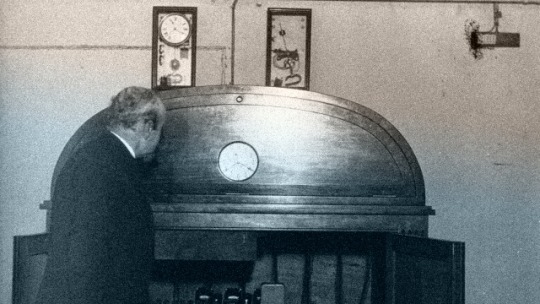#HORLOGE
Explore tagged Tumblr posts
Text

Le beffroi de Roussillon…
#photography#original photography#original photography on tumblr#luberon#provence#beffroi#roussillon#ocre#horloge#ruelle
233 notes
·
View notes
Text

Astrological clock in Venice
42 notes
·
View notes
Text

Horloge 🕰 art nouveau 1920s
Cette nuit on passe à l'heure d'hiver ! 🕒➡️🕑
Bel après-midi 👋
#artwork#art et talent#art nouveau#horloge#heure d'hiver#changement d'heure#sculpture#pendule#art#belaprèsmidi#fidjie fidjie
49 notes
·
View notes
Text

La Grosse Horloge de Rouen de style gothique (1390s), l'arcade de 1511 et la fontaine de 1731. Seine-Maritime.
46 notes
·
View notes
Text

Edward Lamson Henry, La vieille horloge sur l'escalier.
9 notes
·
View notes
Photo

14 février 1933 : premier service d’horloge parlante par téléphone ➽ http://bit.ly/Horloge-Parlante-Telephone « Homme du jour » ou « homme de l’heure » ?... s’interroge "Le Petit Parisien" au lendemain de l’inauguration à Paris du premier service d’horloge parlante accessible par téléphone, inventée par Ernest Esclangon, astronome et mathématicien
#CeJourLà#14Février#Horloge#Parlante#Téléphone#Observatoire#Paris#Astronome#Mathématicien#Esclangon#histoire#france#history#passé#past#français#french#news#événement#newsfromthepast
11 notes
·
View notes
Text

Credit : Creaofhelia
Château de Bouges, Centre Val de Loire, France
#photography#photooftheday#france#artists on tumblr#photographers on tumblr#my photos#kingdom#bridgerton#chateau#horloge#history#architecture
5 notes
·
View notes
Text

50 years ago… official ASTP NASA crew photos In January 1974 NASA released official crew photos of the astronauts for the upcoming Apollo Soyuz Test Project (ASTP) mission. These three NASA astronauts are the American flight crew for the 1975 ASTP mission. The prime crewmen for the joint U.S.-Soviet Union space flight are, left to right, Donald K. Slayton, docking module pilot; Vance D. Brand, command module pilot; and Thomas P. Stafford, commander. The crew was announced on January 30, 1973. The backup crew were Alan Bean, Ronald Evans and Jack Lousma. Posing in their white space suits with a scale model of the Apollo-Soyuz capsules in docking mode in front of them. Note both Deke Slayton and Tom Stafford wore their Gold “Apollo 11 tribute” Omega Speedmaster chronographs, respectively numbers 27 & 13, awarded in November 1969. (Photo: NASA S74-15241)
#Apollo#Astronaut#861#Speedmaster#chronograph#NASA#MoonwatchUniverse#Omega#space suit#military#montres#ASTP#Apollo-Soyuz#BA145022-69#spaceflight#test pilot#horloge#raumfahrt#uhren#Speedytuesday#Zulu time
11 notes
·
View notes
Text

#phoneography#mobiele telefoon fotografie#mobile phone photography#smartphoneography#smartphone fotografie#smartphone photography#Brussel-Noord#Brussel Noord#Brussel#Noord#Bruxelles#Bruxelles Nord#gare#België#Belgique#Belgien#Belgium#travel#reizen#reisen#voyage#viajar#station#tower#toren#clock#klok#time#tijd#horloge
3 notes
·
View notes
Text

L’horloge de l’Hôtel de Ville d’Ajaccio…
#photography#original photography#original photography on tumblr#corsedusud#ajaccio#hôtel de ville#horloge#fanions
42 notes
·
View notes
Text





Une journée à Arras avec le copain Philippe : en haut du beffroi.
3 notes
·
View notes
Text

"Le temps remet toujours les pendules à l'heure." 🕠
Mazouz Hacène
Gif de Petitemimine
#gif animé#petitemimine#changement d'heure#heure d'été#pendule#quotes#mazouz hacène#horloge#heure#temps#humour#fidjie fidjie
27 notes
·
View notes
Photo






(via Horloge avec l'œuvre « La boite secrète » de l'artiste ATartelin)
#findyourthing#redbubble#redbubbleartist#redbubbleshop#digital art#artists on tumblr#art#print on demand#my art#artiste#digital artist#horloge
2 notes
·
View notes
Text
Manga Witches: Part Seven (Last part... for now!)
Here's the seventh part of the nameless manga witch series! This is the second half of witches that showed up in the climax battle of Tart Magica! This'll be the final part, though if anyone knows of any other unnamed witches that could be discussed, do comment below!!!
All of these witches were done alongside @honestlyboringperson!

I'll start off with Cochineal, the snail witch with a repulsed nature, it spends its days in the mirror, insulting the reflection in it. It detests its slimy visage, so it orders its familiar to tear off its skin, knowing that their true beauty is on the inside. The witch cannot feel pain, and powerful regeneration, making the familiars' duties pretty much pointless. As with any other snail, the best method to beat this witch is salt. Once the witch has dissolved, all that left will be a mysteriously beautiful skeleton.

Phiphi, the witch of tentacles with a searching nature, this witch lacks any sense aside from touch, so it wanders around, wriggling itself on everything. It's surprisingly passive for a witch… typically. If provoked, it will attack like any other, unfortunately, due to lack of sight, it may instead go against one of its own guiding familiars. This witch is looking for something she lost that only it knows, not even the familiars know what it is. Whether it be a lost sock, or a dear partner, it won't stop stumbling around until it can be found. The next witch discusses slight themes of sexual trauma, so warning beforehand.

Kore, the witch of lace, with a sullied nature. A witch whose surprisingly innocent for her size, she searches for a sweet love that can fit her standards, but all her familiars due is chase her around in a vicious manner, she then wallows in horror in her den until the next day, denying the last day's events with her beaming innocence.

Horloge, the clock witch. Her nature is awaiting. A witch who hopes she can stop being a magical girl since that caused her a lot of pain and brought a lot of despair to her days. Even though she's a witch, she still thinks she's a magical girl. Tick tock tick tock, her clock chimes like this and she awaits for a moment that will never come and she will continue to think that she is a magical girl, unless she is annihilated at this very moment. Apart from awaiting, if a magical girl is found, she will use the sharp needles that protrude from her body to kill said magical girl and give her a painless death, but only to later feel envy since is dead and she is not. This witch was written by @shitposterxdxdxd rather than me or @honestlyboringperson.

Fovea, the oculus witch. Its nature is falling in love at first sight. It can't help but fall in love with anything it see, it holds on to those it loves with its dreadfully tight appendages then it gets sad over its death of suffocation, and does it all over again.

William le Bel, the heraldry witch with a misleading witch. This witch has a strong and prideful outwards appearance, but in actuality is a tame coward. It worries day in and day in out over disappointing their forefathers. Despite its fearfulness, it's still quite strong with the powers it has inherited, so it's better for you to ease the witch's troubles and let it move on peacefully rather than taking it down like other witches.

Vassilyev, the hut witch with a with a cozy nature. She feeds visitors with soup and bread that little does she know is rotten to the core, and she warms their souls with blankets she lovingly knits, but they are heavy enough to crush them flat. She once was a warm house filled with memories but now she is empty, gathering dust, unaware of the suffering she causes to guests. She is devastated when her guests die and will not stop mourning them until a new victim arrive, she'll forget what she was even crying in the first place.

1889, the gramophone witch with a reminiscing nature. This witch is nostalgic of its past, though for this witch in this time period, the past for them is the future, for they were once a person who wished to explore time, and ended up in the wrong place in the right time. The witch plays ragtime music that causes victims to erupt into a dancing disease. The lore behind this last witch is that rather than being a meguca who resides in medieval France, it was a girl who time traveled from the late nineteenth century and ended up transported to the battlefield by Minou before being forced into becoming a witch, making end up in the wrong place in the wrong time. The name, 1889, comes from the year the girl traveled from.
#obscure witches#witch#madoka magica#tart magica#collab#cochineal#snail#phiphi#tentacle#kore#lace#fovea#oculus#vassilyev#hut#horloge#clock#william le bel#heraldry#1889#gramophone
16 notes
·
View notes
Text
Après le sablier, l'horloge à feu. C’est en Asie que l’horloge à feu voit le jour, et particulièrement en Chine – le Japon l’a adoptée par la suite. Des traces de son utilisation remontent jusqu’au VIe siècle avant J.-C. Venant remplacer le sablier, qu’il fallait retourner à intervalles réguliers, elle permettait de mesurer le temps par l’emploi d’un combustible dont le brûlage était à la fois lent et uniforme, donc prévisible – bougie ou huile contenue dans une lampe. Elle arrive en Europe au VIIIe siècle, par le Vénérable vers l'an 700. Il eut l'idée de graduer un cierge qui permettait de mesurer le temps avec une certaine exactitude. On pouvait ainsi connaître les heure nocturnes, ce qui était très important pour les congrégations religieuses afin de respecter les horaires des prières. De fait, les premiers usages de l’horloge à combustible sont réservés aux congrégations religieuses, afin qu’elles puissent respecter au mieux les horaires des prières durant la nuit. Trois cierges d’un mètre sont généralement nécessaires pour arriver jusqu’à l’aube. Ce dispositif s’est néanmoins rapidement propagé dans toute l’Europe médiévale. Ces horloges pouvaient aussi servir de réveil-matin. En fixant un fil muni de poids à un endroit précis, dès que la combustion atteignait ce fil, le poids tombait dans un réceptacle métallique qui tintait comme une cloche. La bougie a donc, depuis toujours, été un symbole de l’écoulement de la durée, et sa combustion la représentation de la fuite du temps jusqu’à nos jours où l’on continue de souffler les chandelles pour célébrer les anniversaires. Avant l’invention de la lampe à huile, la bougie était utilisée au théâtre pour éclairer la scène et les comédiens – la durée de l’acte était ainsi conditionnée à celle de la combustion de la bougie. Au Moyen-âge, elle était également devenue un symbole de richesse : la bougie en cire, plus luxueuse que son équivalent en suif, était l’apanage des familles riches. Et elle ne pouvait pas être utilisée comme horloge à feu au sein des foyers les moins dotés, qui devaient la préserver le plus longtemps possible. Au fil de ses évolutions et de ses passages d’un continent à un autre, l’horloge à feu a conservé son principe de fonctionnement de base, inaltérable. Il aura fallu l’invention des montres et des horloges mécaniques pour mettre fin à la domination de ce système ingénieux de mesure du temps...

After the hourglass, the fire clock. The fire clock originated in Asia, particularly in China Japan later adopted it. Traces of its use go back to the 6th century. It replaced the hourglass, which had to be turned over at regular intervals, and made it possible to measure time by using a fuel that burned slowly and evenly and was therefore predictable - a candle or oil in a lamp. The fire clock arrived in Europe in the 8th century, possibly adopted (or reinvented?) by Bede the Venerable around 700 A.D. He had the idea of graduating a candle to measure time with a certain accuracy. This made it possible to know the time of night, which was very important for religious congregations in order to respect prayer times. In fact, the first uses of the fuel-powered clock were reserved for religious congregations, so that they could best keep to their prayer times during the night. Three one-metre candles are usually needed to make it to dawn. However, this device quickly spread throughout medieval Europe. These clocks could also be used as alarm clocks. By attaching a wire with weights to a specific point, as soon as the combustion reached the wire, the weight fell into a metal receptacle that rang like a bell. The candle has thus always been a symbol of the passage of time, and its burning the representation of the flight of time until today, when candles are still blown out to celebrate birthdays. Before the invention of the oil lamp, the candle was used in the theatre to light the stage and the actors the duration of the act was thus conditioned by the burning of the candle. In the Middle Ages, it also became a symbol of wealth: the wax candle, more luxurious than its tallow counterpart, was the privilege of rich families. And it could not be used as a fire clock in the less wealthy households, which had to preserve it as long as possible. As it evolved and moved from one continent to another, the fire clock retained its basic, unalterable operating principle. It took the invention of mechanical clocks and watches to put an end to the domination of this ingenious system of time measurement
https://www.ohselection.com/
http://michel.lalos.free.fr/
Octobre MMXXIV
6 notes
·
View notes
